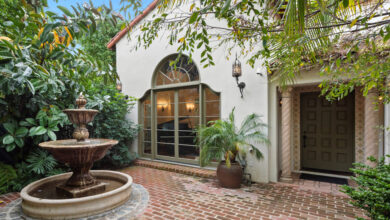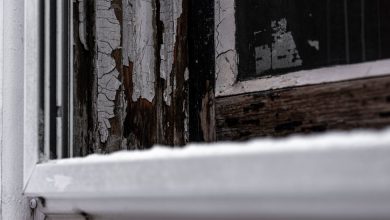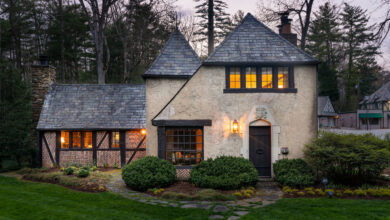At Stoneleigh, Landscaping With Native Plants Is Possible

[ad_1]
The task facing anyone designing a garden: “We’re predicting the future — we’re seeing what’s not there.”
That’s how Ethan Kauffman, the director (and lead soothsayer) of Stoneleigh, a public garden that opened five years ago on a historic estate in Villanova, Pa., puts it.
The thing is, garden-makers also have to see what is there. In the case of the 42-acre Stoneleigh, that included seven acres of pachysandra, when Mr. Kauffman first saw the property almost seven years ago.
In any context, a sea of what was once a go-to ground cover — which proved to be one of ornamental horticulture’s ubiquitous legacy invasives — would be overwhelming. But Mr. Kauffman, the former director of Moore Farms Botanical Garden, in South Carolina, was hired to fulfill a mission that makes it even more challenging.
He is guided by what he calls the “conservation ethos” of Stoneleigh’s parent organization, Natural Lands, a nonprofit group that currently cares for more than 23,000 acres in eastern Pennsylvania and southern New Jersey — at 42 nature preserves and at Stoneleigh — and has preserved more than 135,000 acres over its history, since the 1950s.
To complicate things further: Each garden feature he conceives must somehow complement the backdrop of a Philadelphia Main Line estate, with its 17,000-square-foot Tudor Revival stone mansion and massive, century-old stone pergola.
Can an ecologically focused landscape of native plants be integrated into such a place? The answer from Natural Lands and the Stoneleigh horticulture team is emphatic: Yes.
First Things First
When Mr. Kauffman arrived, the property hadn’t been gardened in more than four years, beyond basics like mowing. Where to begin?
His crew — which has just five full-time members and one seasonal horticulturist — went at some of the pachysandra-infested acres. (The current score: two down, five to go.) They knew it would be easy to fall into that forest-for-the-trees trap, though, getting distracted by the obvious when the less-so is more urgent. So they emphasized higher-value tasks. Their priority list would make a good road map for beginning or revamping a garden of any scale or purpose.
First, they identified a couple of key areas to focus on in the initial phase, to establish their larger intention — an early statement previewing longer-term goals.
Also critical, in self-defense: Any bare ground is an invitation to weeds, and will require many hours of maintenance if left vacant. So they planted empty spots as soon as they could.
Third, where trees and shrubs were part of the eventual plan, they knew they had to get them into the ground. This was especially urgent with the natives Mr. Kauffman had specified for the renewed landscape, many of them new or uncommon in the nursery trade and only available in small sizes. The time spent waiting for the payoff would be extra-long.
Identifying key areas for maximum impact was easy: The parking lot would make the first impression on all visitors — currently about 40,000 a year, admitted free Tuesday through Sunday, except Thanksgiving and Christmas.
But about an acre of pachysandra lived there. Ten dump-truck loads were evicted in favor of combinations like pink flowering dogwoods (Cornus florida Cherokee Brave) underplanted with golden ragwort (Packera aurea). The ragwort’s yellow flowers coincide with the trees’ spring bloom, creating a friendlier welcome mat.
The main house, formerly home to the Haas family, was another key destination. It needed some botanical brightening, as did the majestic, 220-foot-long pergola. Beneath the pergola grew turf, not the beds of perennials that Mr. Kauffman envisioned. It begged for vines to clamber up and over it, too.
“The pergola is really charismatic,” he said. “We thought this was something that if we could do one small section — and hopefully do a good job with it — it would give visitors an idea of what was to come.”
Also, he added, it was “an opportunity to showcase a lot of native vines that people may not be using.”
Today, 24 types of native vines climb the pergola, including the lesser-grown yellow passionflower (Passiflora lutea) and a domestic subspecies of hops (Humulus lupulus ssp. americanus), its female flowers clustered in little green, pine-cone-like structures. Small-flowered Clematis share the real estate, along with a Victorian favorite loved for its giant leaves and the curious, hidden flowers that inspired its common name, Dutchman’s pipe (Aristolochia macrophylla).
On another pergola upright, prairie rose (Rosa setigera) has already reached 20 feet. It is also being trained to transform lampposts on the grounds into flowering pillars.
Select varieties of the more familiar trumpet honeysuckle (Lonicera sempervirens) and trumpet creeper (Campsis radicans) are making a big splash as well, along with American wisteria (Wisteria frutescens) — not the invasive Chinese species.
A design trick with the honeysuckles and trumpet creepers: “We plant them in clusters of three,” Mr. Kauffman said, “with a red, yellow and orange variety all in the same hole, to create these colorful bursts.”
Some home gardens have no such vertical structure, but that needn’t mean no vines.
“People say, ‘I love wisteria, but I can’t fit it in my yard,’” Mr. Kauffman said. “And I’m like, ‘Well, yeah, you can. You can treat it as a shrub.’”
Once in the ground, the young one-gallon plants are staked up and then pruned immediately after flowering, and again later each year, as needed.
The woodvamp (Decumaria barbara) is treated similarly — and could double as a ground cover.
“I just look at plants and I think, ‘What are the possibilities?’” Mr. Kauffman said. “And we experiment with them. That’s what we do as gardeners, right? We’re just having fun.”
Trees With a Difference, Hedges With Intention
Mr. Kauffman is exploring versatility — and not just with vines. The pergola plantings include trees like weeping yellowwood (Cladrastis kentukea White Rain) that are pruned to train up it.
The skeletons of two venerable dead trees — an English yew (Taxus baccata) and a London plane tree (Platanus x acerifolia) — were not erased, but turned into prominent sculptures. Others left standing as snags, or wildlife trees, host bird and mammal families, and support more native vines.
On the stone walls of the mansion, Eastern redbud (Cercis canadensis) and box elder (Acer negundo) are espaliered, anchored by eye hooks screwed into the mortar, as are more vines, and shrubs.
Witch hazel (Hamamelis virginiana), specifically showy Lemon Lime, inhabits one wall. “It’s this crazy, variegated green-and-yellow selection that looks like something out of ‘The Matrix,’ but it’s pretty striking,” Mr. Kauffman said.
On the big, covered stone gates, or lychgates, the white-flowered weeping Eastern redbud Vanilla Twist is trained, vine-like, around the posts. “We cut all the lateral branches off,” he said, “and just let it sort of do its thing.”
When he arrived at Stoneleigh, there weren’t really any hedges. “Most of the experience was just this open sort of journey,” he said. “You didn’t really have anything dividing it, or creating visual barriers, and we knew that would be important later on.”
One beautiful example is a line of dwarf Teddy Bear Southern magnolias (Magnolia grandiflora). White pine (Pinus strobus) teams with American arborvitae (Thuja occidentalis Smaragd) in another hedge, with a lone, gold-foliage arborvitae Yellow Ribbon in the row, screaming for attention.
Shrubs-into-hedges include groundsel bush (Baccharis halimifolia), hearts-a-bustin’ (Euonymus americanus) and an obscure native, upland swamp privet (Forestiera ligustrina), “a great replacement for our nonnative privet,” Mr. Kauffman said, referring to another serious invasive.
“And we have this crazy wildlife hedge that has 70 different varieties of native woody plants, in a double row,” he said. “It’s 200 feet long, about eight feet tall. We have vines in there, and perennials — it’s kind of a dynamic thing.”
Covering Some Ground
The hedges are just one “cue for care,” Mr. Kauffman said, a sign that this is a garden — although a less conventional one than its predecessor.
The team’s approach to what was once 14 acres of mowed turf is another hint.
“We’ve let at least half of it go into no-mow, and it looks so beautiful,” Mr. Kauffman said. “We mow the edges — the first six feet — so you can tell that we’re caring for it, but the rest we just let grow long.”
Fewer weeds are another sign of human intervention. Living “green mulch,” in the form of ground cover, is the main tool in Stoneleigh’s campaign against them.
Golden ragwort gives good coverage against unwanted species, as does barren strawberry (Geum fragarioides, formerly Waldsteinia). Sedges (Carex), Canada ginger (Asarum canadense) and creeping phlox (Phlox stolonifera) are other powerful partners in this no-bare-ground effort against weeds.
“As a small staff, you just have to find a way,” Mr. Kauffman said. “And we experiment: With bare, weedy areas we’re sick of pulling, we’ll plant just Parthenocissus. And in a year, we don’t have to deal with it.”
That may surprise gardeners who too often pull up Virginia creeper (Parthenocissus quinquefolia) or thicket creeper (P. inserta), native vines that are often misunderstood, despite their high wildlife value and brilliant fall color.
Could we shift our thinking and start to figure them into our garden plans? That depends on our mode of seeing — on how we visualize the way forward.
Margaret Roach is the creator of the website and podcast A Way to Garden, and a book of the same name.
For weekly email updates on residential real estate news, sign up here.
[ad_2]
Source link






